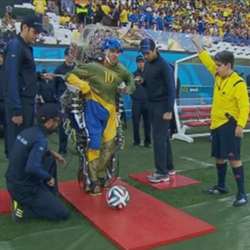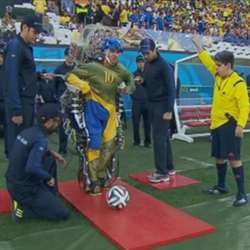
"Mind over matter" is a phrase used to figuratively describe a person’s will to overcome a challenge, but several research groups are taking that idea to heart, working on technology that will allow a person to intuitively control an exoskeleton, a wearable frame that holds a person’s body weight and moves their limbs when instructed.
The technology is based around the theory that each physical movement of a body part can be tracked back to a unique electrical impulse within the brain that triggers that motion. By capturing these brain waves, analyzing and mating them to specific movements, and training people to pay close attention to the thoughts that control a specific action, an exoskeleton’s movements can be directly controlled by the wearer.
The highest-profile project in this arena is called the Walk Again Project, a consortium of hundreds of people from universities and research institutes being led by Duke University neuroscientist Miguel Nicolelis. The team presented a live demonstration of its thought-controlled exoskeleton at the opening ceremonies of the World Cup in Sao Paulo, Brazil, at which Julio Pinto, a 29-year-old man with complete paraplegia of the lower trunk and lower limbs, stood up and kicked a soccer ball with the assistance of an exoskeleton controlled by his mind.
The exoskeleton is controlled by a 3D-printed helmet and a concealed cap of electrodes, which pick up electrical signals from the brain, known as electroencephalograph (EEG) waves. The cap is connected to a backpack containing wires and a computer that decodes these signals and matches them to movement patterns, which then control the exoskeleton’s limbs via a series of actuators.
Other teams, less high profile in nature, are working on similar projects designed to provide brain-control of exoskeletons. Guy Cheron, a professor at the Laboratory of Movement Biomechanics at the Université Libre de Bruxelles (ULB) in Belgium, heads up the Mindwalker project, which uses three methods of capturing instructions from the body to aid in the control of an exoskeleton.
Cheron explains the Mindwalker system is equipped with an automatic detection system to identify the center of the person’s mass, in order to trigger the correct gait while walking. The second part of the system uses EEG waves as a brain-computer interface, through a cap that measures electrical activity from the surface of the scalp, similar to the one deployed by the Walk Again Project. Finally, the third technology involves the usage of an electromyography (EMG) of the deltoid muscles of the upper arm, which records the muscle activity of the upper limb is and is transformed to produce the synchronous movement of the lower limb that occurs normally when moving the arm during walking.
The biggest challenge, according to Cheron, is the elimination of electrical "noise," which can negatively impact the ability to capture accurate brain impulses. Cheron and his team has developed technology using glasses that would detect the intention of the subject by capturing and converting a specific eye-flickering pattern, and then translating that pattern to trigger a specific action.
"In this protocol, subjects have to focus on a flickering LED that will trigger a specific command (right leg movement, for example)," Cheron says. "The system recognizes the LED that is watched, and acts as if the person activates a button command without really touching the button that [triggers] a defined action. In that sense, there is some pre-programmed behavior concerning exoskeleton. Patients just send a start command that will automatically generate walking."
Two other projects are working on their own versions of mind control of body parts.
Andrew Schwartz, a professor at the University of Pittsburgh, has permanently implanted arrays of microelectrodes in the motor cortical areas of the brains of monkeys. Schwartz connected these electrodes to an anthropomorphic robot arm, which uses the extracted velocity signal as an input to an inverse kinematic algorithm that gives joint-angles for each of the four robot motors to allow it to move.
Daniel Ferris, professor of Movement Science and director of the Human Neuromechanics Laboratory at the University of Michigan, is working on pneumatically-powered lower-limb exoskeletons as possible motor training aids after neurological injury; these use artificial pneumatic muscles (sometimes called McKibben muscles) to actuate the exoskeletons. In addition to hand and foot-switch controllers, Ferris is working on a way to use brain imaging to send signals to these lower-limb exoskeletons.
The goal with all of these projects is to allow those who have been confined to a wheelchair to stand up and walk simply using their mind, and the demonstration at the World Cup would seem to indicate that significant progress is being made. Ferris, however, has expressed a bit of skepticism on the demonstration of the Walk Again Project, commenting that "from what was presented, it does not appear to be a major advance. We will just have to wait to see its capabilities when they publish a paper on it."
Similarly, Cheron notes that his team’s technology, while making advances, is unlikely to be ready for commercialization in the near future. "The technology will be ready in 2018," Cheron says. "It would be great to have it commercialized for this date, but we have to be pragmatic in the sense that there remain(s) a lot to be developed."
Keith Kirkpatrick is principal of 4K Research & Consulting, LLC, based in Lynbrook, NY.




Join the Discussion (0)
Become a Member or Sign In to Post a Comment